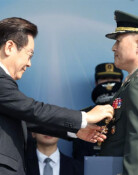Professor Uses Fasting to Treat Obesity
Professor Uses Fasting to Treat Obesity
Posted November. 14, 2005 03:07,

Professor Shin adopted fasting as a method for treating obesity in 1985. The core of his treatment originally was a type of fasting that cut off all types of nourishment. When he first adopted this method, modern medicine as well as oriental medicine colleagues disapproved of it, and some even called him a quack.
The Big Gap Between Scientific Verification and Reality
On October 28, a 32 year-old lady came to see Shin. Her weight was 74.7 kg, and her body fat weighed 30.9 kg. Shin admitted her to the hospital and for the first few days, reduced his patients food intake. Then he made her fast.
Just because one is fasting does not mean that one has to be lying in bed. In order to eliminate toxins accumulated in the body, she had her intestines cleansed every four days, as well as daily Buhwang (detoxification by applying air-sealed cups on the body). In addition, all available means such as Chi exercises and Taichi, laser and music therapy, massage, and hot and cold baths were used.
The patient was released from the hospital on November 7, 11 days after her admission. At the time of the release, her weight was 67 kg, and body fat 28.1 kg.
However, Shin said, The treatment is not yet finished. In all, she had to undergo four stages, and she has only finished the first and second stage of reducing food and fasting. The third stage is a drug therapy, where she will take a concoction of herb medicines, and the fourth stage is a dietary treatment. It takes about four months to finish all the stages. The patient is currently on her third stage.
For a modern physician, fasting treatments that prolong themselves over 10 days are unscientific. In fact, only the Korean Oriental Association for Study of Obesity magazine carried a thesis regarding this treatment. It has not been printed in any famous scientific publication. In other words, it has yet to be tested by modern medicine, which Shin also admits.
However, how are you going to explain that the patient sees results? Science clearly has great value, but we should not blindly trust it. Testing should proceed in the future, but in the present this treatment should not be excluded.
Distinguish Between Alternative Medicine and Questionable Commercialism
Currently, various oriental medicine doctors are using the fasting treatment of Shin. Although, it lacks a modern medical background, it has clinically proved that it actually yields results. Shin has been emphasizing, You should not reject new methods just because they are new. Even if it lacks scientific background, if over 60 percent of the patients have seen results, if it cant be accepted, he then at least wants the treatment to be considered.
Shin ordains fasting as a natural science. According to him, fasting first started from religion. Traditional medicine was the first to adopt it, and alternative medicine adopted it from there, hence we have the current fasting treatment. Shin explains that when fasting the sixth sense develops, hence improving immunity, which leads to treatment results. It is to be observed whether Shins method will be proved through modern medicine.
In his opinion, people need to continuously make new theories and test them. In fact, in the modern oriental medicine field the Four Body Types are being subdivided into eight, and even 16, while receiving strong opposition from the traditionalists.
Nevertheless, one should know the difference between phony commercialism and future treatments, and Shin offers two standards.
The first is whether the practitioner is a certified doctor. It is very likely that if the practitioner is not a doctor, chances of being a hoax are very high. Another standard is whether the treatment or therapy has been registered to health authorities. Shin said that even if it claims to be new, if it has not been registered, it should be cautioned.
Sang-Hoon Kim corekim@donga.com




![“‘휴지심’ 아직도 버려?” 0원으로 집안 환경 바꾸는 법 [알쓸톡]](https://dimg.donga.com/c/138/175/90/1/wps/NEWS/IMAGE/2026/01/07/133110227.3.png)

![쓸개 파열로 “사흘 남았다” 판정받은 시인…18년뒤 “너를 아껴라” 속삭여[손효림의 베스트셀러 레시피]](https://dimg.donga.com/c/138/175/90/1/wps/NEWS/IMAGE/2026/01/08/133113134.1.jpg)
